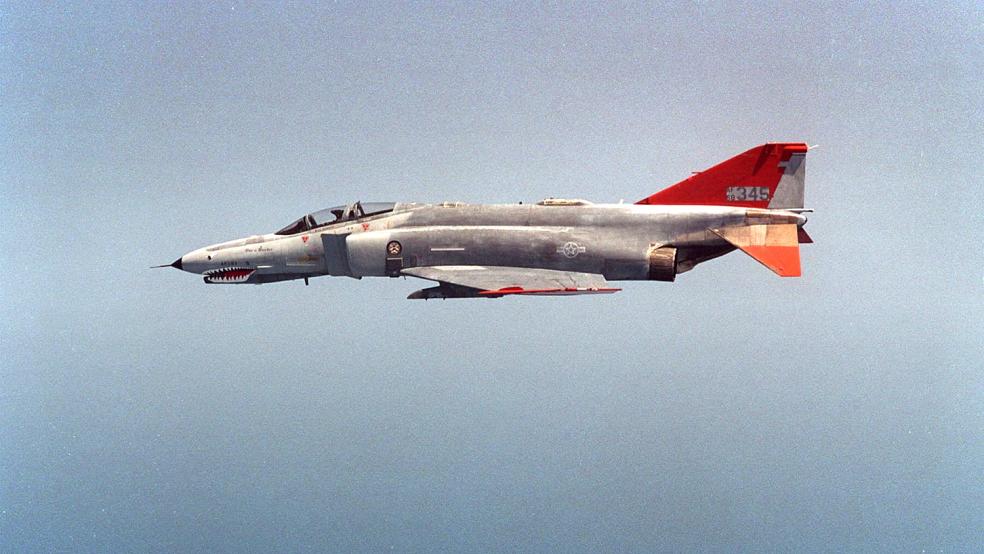Facing a shortage of pilots, dollars, and training time, the Pentagon wants private pilots and fighter jets to play the bad guys during dogfighting and other drills with military pilots.
While contractors have long been used in various kinds of military training, top Defense Department officials believe this new role could free up uniformed pilots to fly in combat squadrons.
Related: America’s High-Tech F-35 Is Poised to Purge ISIS from 30,000 Feet
“That is something that is actively under consideration,” Air Force Secretary Deborah Lee James said Tuesday at a Defense One leadership briefing. “We have to see how the dollars and cents work out.”
The military uses “aggressor squadrons,” like the one commanded by “Viper” and “Jester” in the 1980s film “Top Gun,” to simulate enemy tactics. Sometimes they even fly enemy aircraft. During the Cold War, the Air Force actually got its hands on Soviet MiG-17, MiG-21 and MiG-23 fighters, secretly flying them from a remote air force base in the Nevada desert.
For adversary training today, the Air Force uses T-38 Talons, jets that date back to the 1960s. It also operates aggressor squadrons of F-16s at Nellis Air Force Base in Nevada and Eielson Air Force Base in Alaska. Those jets, painted in blue, brown or black camouflage, fly against American combat pilots in high-end war games. In 2006, Gen. T. Michael Moseley, the Air Force chief of staff, added F-15 Eagles to the aggressor wing at Nellis, but that unit was deactivated in 2014.
But fying and maintaining high-end aggressors, like the F-15 and F-16, is expensive and removes pilots from combat squadrons, according to defense executives.
Related: The Pentagon ‘Slush Fund’ That Could Threaten National Security
Now the military is considering companies to fill that void. “It is a training approach that could well work,” James said.
The list of companies with private fleets of high-performance, military aircraft, and pilots who can simulate foreign tactics is fairly small. Among them is Florida-based Draken International, which flies adversary missions for the U.S. and foreign militaries. Draken is working with Montreal-based CAE to compete for a Canadian aggressor contract, a deal that if won could broaden the cooperation between the two firms. There’s also Discovery Air, headquartered outside of Toronto, which does similar work for the Canadian Forces and German air force.
The market is also attracting new entrants. Earlier this month, Rhode Island-based Textron created Textron Airborne Solutions to compete for this type of business globally. It recently acquired the Airborne Tactical Advantage Company, whose jet aircraft already do this type of work for the U.S. military.
Cadres of former military pilots at these companies largely fly decades-old fighter and training jets, like the K-21 Kfir, A-4 Skyhawk, Mk-58 Hawk Hunter and L-39 Albatros.
“What we see out here is a growing interest and a growing need for outsourcing certain traditional military training tasks that [the Pentagon] used to always handle,” said Russ Bartlett, CEO and president of Textron Airborne Solutions.
The Airborne Tactical Advantage Company trains Navy Super Hornet pilots who are learning to fly the jet for the first time or studying advanced tactics at Top Gun, the Navy Fighter Weapons School, said Jeff Parker, CEO of the Airborne Tactical Advantage Company. Carrier Strike Groups made up of ships and aircraft train against the firm’s aggressor jets before deployments. The company also trains ground controllers who call in airstrikes.
“The industry that we began is literally exploding,” Parker said.
This article originally appeared on Defense One. Read more from Defense One:
Vladimir Putin’s Best Summer Ever
Pentagon Opens Boston Tech Outreach Office, With an Eye to BioTech
China’s Rising Near This Key US War Base. Here’s How We Push Back




